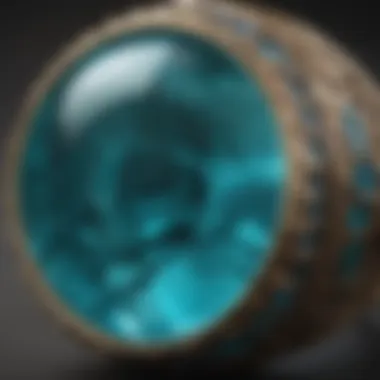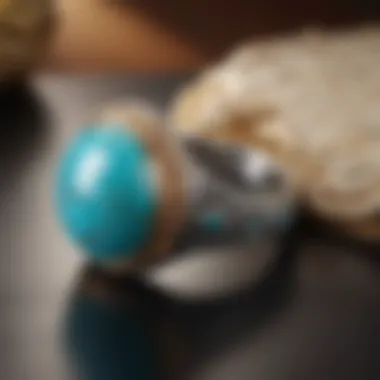Evaluating the Value of Turquoise Rings: A Comprehensive Guide


Intro
Turquoise rings have long fascinated jewelry enthusiasts and collectors alike. Their unique combination of vibrant colors and rich history makes them stand out in the world of gemstones. This article aims to dissect what contributes to the value of turquoise rings while paving the way for a deeper understanding of the criteria that influence their worth.
Overview of Gemstones and Minerals
History of Gemstone and Mineral Use
The use of gemstones dates back thousands of years. In ancient cultures, gemstones were believed to hold powers, serving both aesthetic and spiritual purposes. Turquoise, in particular, has been revered by Native American cultures. It symbolizes protection and healing, often featured in amulets and talismans.
Significance in Culture and Society
Distinct colors of gemstones like turquoise have made them significant to various societies. From the Egyptians using turquoise in burial rituals to modern contemporary artists embracing its hues, this stone continues to have cultural relevance. Understanding how these historical contexts influence present values is crucial for any collector or enthusiast.
Gemstone Formation and Properties
Formation Process of Gemstones
Gemstones form through geological processes that often take millions of years. Turquoise is typically found in arid regions, forming from the interaction between acidic copper and aluminum-bearing environments. This process gives turquoise its unique, often blue to green shades.
Properties that Define Gemstones
The properties of gemstones guide their classification and valuation. For turquoise, both color and clarity take center stage, as they significantly sway market perception. The gemstones can show a range of patterns, enhancing their uniqueness.
Classification based on Color, Hardness, and Luster
Turquoise is classified as a semi-precious gemstone. Its luster varies from waxy to sub-vitreous. The hardness typically falls between 5 and 6 on the Mohs scale, which affects its durability and suitability for different types of jewelry.
Identifying and Evaluating Gemstones
Factors Affecting Gemstone Value
Several factors dictate the value of turquoise rings:
- Quality of the gemstone: The uniformity of color, the presence of matrix, and clarity matter.
- Craftsmanship: The skill of the artisan impacts the overall appeal of the ring.
- Market demand: Trends can shift values significantly.
Techniques for Gemstone Identification
Identifying genuine turquoise involves various methods. Simple tests include examining the stone's weight and surface texture. More advanced methods involve spectroscopy and X-ray diffraction.
Assessing Gemstone Quality
When it comes to quality assessment, consider:
- Color intensity
- Clarity or presence of imperfections
- The way it is cut and polished This systematic evaluation is vital in understanding worth.
Caring for Gemstones
Cleaning and Storing Gemstones Properly
Alongside evaluating gemstones, proper care is essential. Turquoise requires gentle cleaning, often preferred done with a soft cloth because harsh chemicals can damage the stone.
Avoiding Common Mistakes in Gemstone Care
Common errors include exposing turquoise to high heat or immersing it in water for prolonged periods. Such conditions can lead to degradation over time.
Preservation Tips for Specific Gem Types
For turquoise, store it in a cool, dry place, away from direct sunlight. This simple practice can greatly enhance the longevity of your gemstone.
Understanding the various aspects of turquoise and its valuation process can empower buyers and collectors alike. Knowing what to seek can maximize both aesthetic joy and investment value.


Understanding Turquoise
The topic of understanding turquoise is crucial in evaluating its value, as it lays the foundation for comprehending its unique characteristics and significance. Turquoise is not just a beautiful gemstone; it carries historical, cultural, and personal meanings that can influence its worth. Knowing its composition and variations informs buyers, collectors, and enthusiasts about the quality and potential value of their pieces.
This section dives into the essence of turquoise, offering insights into its definition, variations, and natural origins. By grasping these fundamental aspects, readers can make informed decisions when it comes to purchasing or appraising turquoise rings.
Definition and Composition
Turquoise is a blue-to-green mineral, primarily composed of copper and aluminum phosphate, and it forms in the presence of water that interacts with feldspar or other minerals. The distinct color of turquoise arises from the presence of copper. The exact shade can vary widely, from vivid sky blue to soft green hues. This variation is due to small amounts of iron or other variables in the geology of the region where the gemstone is formed. Turquoise is valued not only for its aesthetic appeal but also for its composition, which directly affects durability and overall quality.
Natural vs. Treated Turquoise
When assessing turquoise, it is essential to differentiate between natural and treated versions. Natural turquoise is mined directly from the earth and remains unaltered. Conversely, treated turquoise undergoes various processes to enhance color, durability, and appearance. These treatments can include stabilization, where resin is applied to improve the integrity of softer stones. Buyers should be cautious, as treated stones generally hold less value than their natural counterparts. Understanding these distinctions is vital for anyone interested in genuine turquoise.
Sources and Locations
Turquoise is found in several locations worldwide, each offering unique characteristics that influence value. Notable sources include:
- Iran: Esteemed for producing high-quality turquoise with a rich blue hue and often a spiderweb matrix.
- United States: The states of Arizona and New Mexico are well-known for their turquoise mines, producing a wide range of colors and patterns.
- China: Increasingly recognized for producing treated turquoise at various price points.
Each location contributes to the overall quality, and variations in color and matrix affect how the gemstone is appraised and cherished among collectors. Understanding these geographic nuances adds depth to the valuation process and appreciation of turquoise rings.
Factors Influencing Value
The valuation of turquoise rings is a complex process, requiring an understanding of multiple elements that determine their worth. Each factor plays an essential role, shaping the desirability and market price of these pieces. From the quality of the gemstone to the craftsmanship involved, every detail can influence value. Additionally, cultural significance and current market demand further complicate the assessment. Understanding these aspects can help buyers, sellers, and enthusiasts better appreciate the worth of turquoise rings within different contexts.
Gemstone Quality
Color and Tone
Color and tone are critical elements when evaluating turquoise. The most valued turquoise displays a vivid blue, often referred to as "Robin's egg blue," with variations including greenish blues and darker shades. The richness of color can drastically influence value. A deeper, more saturated hue often commands a higher price. The consistency of color across the stone is also significant, as uneven coloration can detract from its worth.
A key characteristic of color in turquoise is its ability to evoke emotional responses. Many collectors prefer the bright, rich hues as they are often associated with beauty and rarity. The unique feature of turquoise's color lies in its source; certain mines produce distinctive shades, making them highly sought after. For example, turquoise from the Sleeping Beauty mine in Arizona is renowned for its striking blue tone, elevating its desirability in the market.
However, there are disadvantages. Faded or washed-out colors weaken a ring's appeal and can significantly lower its value.
Clarity and Matrix
Clarity plays an important part in determining how a turquoise ring is valued. Clarity refers to the presence of inclusions or matrix patterns within the gemstone. A cleaner, more translucent stone is often more desired. Conversely, high amounts of matrix, which is the host rock accompanying the turquoise, can impact its clarity and therefore its value.
The key characteristic of clarity is visibility. Stones with fewer flaws tend to have a more polished appearance, appealing to a wider audience. The unique feature lies in the natural variations; some buyers appreciate the matrix patterns, seeing them as signs of authenticity or character in the stone. Yet, while some collectors value matrixed turquoise, others may consider it less appealing, thus creating a potential divide in market value.
Rarity
Rarity is one of the most significant factors in determining the value of turquoise rings. Limited availability of certain types of turquoise can skyrocket prices. Turquoise mines have been closed, limiting the supply of high-quality stones. As specific hues become harder to find, they tend to gain value in the marketplace.
The key characteristic of rarity in gemstones is its intrinsic value; rare items generally demand higher prices. The unique feature of this rarity means that certain stones become coveted collectibles, often passed down through generations. However, it can also create volatility, as market trends can shift dramatically based on supply and demand.
Market Demand
Current Trends
The current trends in jewelry often dictate the market price of turquoise rings. In recent years, there has been a resurgence in popularity for artisan and bohemian styles that prominently feature turquoise. This trend attracts a younger audience and has resulted in increased demand.
The key characteristic of current trends is their ability to create buzz around specific styles. As more designers integrate turquoise into their collections, the interest in the stone grows. The unique feature of these trends is their potential to influence prices significantly; as interest peaks, so too do valuations. However, trends can be fleeting. If the popularity fades, those investments may not hold their value in the long term.
Historical Context
Understanding the historical market for turquoise provides valuable insight into current valuations. Turquoise has been cherished for centuries, particularly in Native American and Middle Eastern cultures. Its use in historical artifacts often enhances its perceived value.
The key characteristic of historical context is its depth of meaning. Buyers often appreciate items steeped in history, viewing them as more valuable. The unique feature of this context is its richness; turquoise rings connected to significant cultural narratives or events can carry a premium price. However, distinguishing authentic historical pieces from replicas can be challenging, impacting buyer confidence.


Cultural Significance
Symbolism in Various Cultures
Turquoise is imbued with cultural meanings across different societies. In many Native American cultures, it symbolizes protection and healing, which significantly boosts its desirability and value as a gemstone. Understanding the cultural significance lends more depth to the evaluation process, as buyers may place additional value on pieces with meaningful stories.
The key characteristic of symbolism is the emotional connection it fosters. A turquoise ring that holds cultural heritage may be valued higher than its material worth. The unique feature of this symbolism adds layers of importance, as buyers aren't just purchasing a ring; they are investing in a piece of cultural history. However, such a significance can make valuation subjective, depending significantly on personal beliefs and values.
Usage in Traditional Jewelry
The traditional usage of turquoise in jewelry adds another dimension to its valuation. Turquoise has adorned jewelry for countless generations. Its inclusion in traditional adornments, such as those found in powwows or weddings, enhances its cultural importance and desirability.
A key characteristic of its traditional use is its enduring popularity; from necklaces to earrings, turquoise remains a staple. The unique feature of this traditional jewelry means there is often a steady market for these pieces, maintaining their value over time. However, distinguishing between genuine traditional craftsmanship and mass-produced items can be challenging for buyers.
Craftsmanship in Jewelry Design
Workmanship and Techniques
The craftsmanship displayed in turquoise rings is a critical factor in their value. Expert artisans employ various techniques, which can elevate a ring from simply functional to a work of art. The level of detail and skill exhibited in the design process influences a buyer's perception of value significantly.
The key characteristic of craftsmanship is its visibility. High-quality workmanship often stands out, attracting collectors. The unique feature of employing traditional techniques speaks to authenticity and artisanal craftsmanship, lending a higher value. However, the challenge is identifying genuine craftsmanship compared to mass-produced jewelry, which can be less appealing.
Designer Reputation
The designer’s reputation plays a crucial role in determining the worth of turquoise rings. Well-known designers often command higher prices simply because of their brand name. A ring created by a respected jeweler can have a significantly higher resale value.
The key characteristic of designer reputation is its impact; pieces from celebrated artists can frequently yield top dollar in the market. The unique feature of this reputation often brings a level of assurance to buyers, indicating quality and desirability. However, reliance solely on reputation can be risky, as not all pieces from famous designers maintain their value over time.
Market Overview
Understanding the market for turquoise rings is critical for anyone interested in their valuation. This overview will delve into how turquoise rings are priced in various settings, specifically retail and auction contexts. Market trends affect prices and availability, making it essential to stay informed about these elements.
The market overview highlights two significant areas:
- Retail Valuation
- Auction Values
Each segment provides insights that influence the overall perception of value and can guide buyers and sellers alike.
Retail Valuation
Jewelry Store Pricing
Jewelry store pricing plays a crucial role in the market value of turquoise rings. These stores offer a transparent pricing structure, which aids buyers in understanding comparable values before making a purchase. The key characteristic of jewelry store pricing is that it often reflects the manufacturer's suggested retail price (MSRP). This standardized pricing gives a sense of security to consumers, knowing they are paying a price aligned with industry norms.
However, jewelry store pricing can be sometimes inflated due to overhead costs. This can deter some buyers who seek more competitive pricing. One unique feature of retail pricing is the ability to physically inspect the product prior to purchase. This tactile experience allows customers to assess quality, which can be a considerable advantage over online shopping.
Moreover, jewelry stores often offer warranties or guarantees, enhancing the perceived value of their products.
Online Marketplace Trends
Online marketplace trends are reshaping how turquoise rings are bought and sold. The rise of platforms such as eBay and Etsy has expanded market reach for both sellers and buyers. A defining characteristic of these online platforms is their diverse range of products. Buyers can find anything from mass-produced pieces to one-of-a-kind artisan rings.
This diversity is beneficial as it allows for more options. However, the disadvantage is that the quality can significantly vary. The unique feature here is the potential for lower prices due to competition and less overhead. Buyers might find good deals, but they also risk encountering unreliable sellers or lower quality products.
Auction Values
Notable Auctions
Notable auctions are venues where rare turquoise rings can reach extraordinary prices. Auction houses like Sotheby's and Christie's have specialized events for gemstones. The key aspect of notable auctions is that they create a sense of exclusivity and urgency. Bidders in these settings often drive prices higher due to competition. The unique feature is that such auctions can showcase exceptional pieces that are not available elsewhere, lending them higher value.
Participating in an auction may expose buyers to market trends and rarity, allowing them to see how much collectors are willing to pay for specific items.


Price Fluctuations
Price fluctuations in the turquoise market can be quite pronounced, influenced by factors such as supply, demand, and market sentiment. The key characteristic is the volatility that can arise from trends in fashion and design. Buyers should be aware that prices can change based on seasonal trends or shifts in consumer preferences. The benefit of understanding these fluctuations is that knowledgeable buyers can time their purchases effectively, potentially acquiring items at lower prices.
However, the disadvantage of this volatility is that it creates uncertainty. Those investing in turquoise rings must be careful and informed to navigate the complexities of these pricing dynamics.
How to Determine the Value of a Turquoise Ring
Determining the value of a turquoise ring is a crucial aspect for both buyers and sellers in the gemstone community. Understanding this value not only helps in assessing the financial worth but also aids in appreciating the piece's unique characteristics. A proper evaluation can assist collectors in making informed decisions, whether for personal enjoyment or investment purposes. The process encapsulates multiple dimensions including professional assessments and a do-it-yourself approach, both of which offer benefits depending on the context of the valuation.
Professional Appraisal
Choosing an Appraiser
Choosing an appraiser is a pivotal step when determining the market value of a turquoise ring. A qualified appraiser brings specialized knowledge that can significantly influence the outcome of the evaluation. These experts often hold certifications from recognized organizations, ensuring they adhere to standardized appraisal practices. The key characteristic of selecting an appraiser is their experience with gemstone evaluations specifically. This expertise leads to a more accurate assessment of quality and value.
A unique feature of professional appraisers is their access to comprehensive market data. They can analyze recent sales trends and auction results to provide a contextually relevant valuation. A possible disadvantage, however, is the associated fee, which can vary from appraiser to appraiser, potentially deterring some individuals considering a simple valuation.
Appraisal Process
The appraisal process itself is systematic and detailed, contributing to the overall goal of acquiring a precise valuation. During this process, the appraiser conducts a thorough examination of the turquoise ring, assessing aspects such as color, clarity, and any enhancements that may affect value. The key characteristic of this method is the thoroughness, as an experienced appraiser often employs a range of tools and techniques to evaluate the gemstone.
One unique feature of the appraisal process is the creation of a formal appraisal report. This document provides vital information, including photographs and detailed descriptions of the ring's characteristics. This formal report is beneficial for documentation, especially if the owner wishes to insure the piece. However, depending on the appraiser's methods, the time required to complete the process can range widely, possibly delaying the valuation results.
DIY Evaluation Tips
Visual Inspection
Visual inspection serves as an accessible method for those looking to determine the value of their turquoise ring independently. This aspect involves examining the ring closely for any visible defects, inconsistencies, or unique features. The key characteristic of visual inspection is that it requires minimal tools—often just a magnifying glass and good lighting conditions.
One significant feature of visual inspection is its immediate nature. Collectors can quickly assess aspects like color saturation and any matrix present in the stone, which plays a role in its value. However, the disadvantage lies in its subjective nature. Without professional training, an appraisal can be easily misjudged, leading to inaccurate evaluations.
Research and Comparison
Research and comparison add another layer to DIY evaluation. This method entails gathering information from various sources about similar turquoise rings to better understand market trends and value ranges. The key characteristic of this approach is its reliance on readily available resources such as online marketplaces, auction sites, and forums like Reddit.
A unique feature of this method is the use of multiple comparison points, allowing collectors to gauge a fair price more effectively. However, this approach also has its downsides; values can fluctuate rapidly in the market, leading to possible inaccuracies in one’s findings. Educated research, combined with diligence, is vital for ensuring a more precise self-assessment.
Future Trends in Turquoise Ring Valuation
Understanding future trends in the valuation of turquoise rings is essential for both collectors and investors. The evolution of consumer preferences, the impact of technological advancements, and the increasing emphasis on sustainability are central to this future landscape. These elements not only shape market dynamics but also influence the perceived value of turquoise jewelry. A thorough insight into these trends can facilitate more informed purchasing and selling decisions.
Sustainability and Ethical Sourcing
Sustainability has emerged as a pivotal consideration within the gem and jewelry industry. Consumers are increasingly aware of the ethical implications of their choices. The demand for ethically sourced turquoise is rising. In this context, transparency in sourcing practices is crucial.
- Impact on Value: Rings that are crafted from sustainably mined turquoise may fetch higher prices. Buyers are willing to pay a premium when they can trace the origins of the gemstone.
- Consumer Preferences: As eco-consciousness rises, businesses that prioritize ethical practices are more likely to attract discerning customers.
- Regulatory Changes: Expect more regulations targeting gemstone sourcing practices. This will likely influence how turquoise is sourced and sold in the future.
By committing to sustainability, jewelers not only appeal to a growing market but also contribute positively to environmental protection and community welfare.
Technological Advances in Gem Assessment
Technological advancements are revolutionizing gemstone evaluation, including turquoise. Innovations in gemology help in accurately assessing quality and authenticity. This can impact the valuation dramatically.
- Improved Identification Methods: Techniques such as laser spectroscopy and advanced imaging can help differentiate between natural and treated gemstones more effectively. This technological edge can lead to transparent pricing in the market.
- Online Platforms: With the rise of e-commerce, tools that allow remote evaluations of gemstone quality are becoming more common. Consumers can now access detailed assessments without needing to visit a physical store.
- Blockchain Technology: This offers a way to securely document the provenance of gemstones. Transparency in transactions enhances trust, which can influence market prices positively.
The End
The conclusion of this article emphasizes the intricate nature of evaluating turquoise rings. Understanding their value extends beyond mere market price; it encompasses emotional and historical significance as well. Recognizing this multifaceted perspective allows collectors, designers, and enthusiasts to appreciate the deeper connections to cultural heritage and artistry.
Final Thoughts on Turquoise Ring Worth
In sum, assessing the worth of turquoise rings involves several layers of analysis. Factors such as gemstone quality, market demand, cultural background, and craftsmanship intertwine to produce a comprehensive valuation. Buyers should consider not only the aesthetic elements but also the ethical aspects of sourcing and the benefits of supporting sustainable practices.
- Emotional Value: Many turquoise rings carry personal stories, enhancing their worth significantly.
- Collector Interest: Rarity plays a crucial role; unique pieces can demand higher prices due to their limited availability.
- Artistic Craftsmanship: The skill and reputation of the jeweler can also impact value. Well-known artisans often bring higher prices due to their established worth in the market.
By understanding these elements, individuals can make more informed decisions about purchasing, valuing, and selling turquoise rings. Ultimately, the worth of a turquoise ring encompasses more than its price tag; it reflects personal stories, cultural narratives, and artistic expression.







